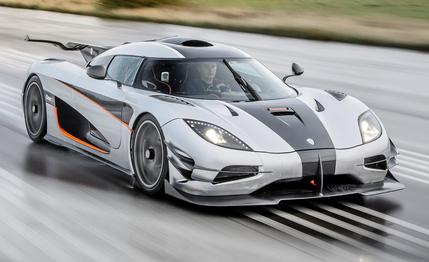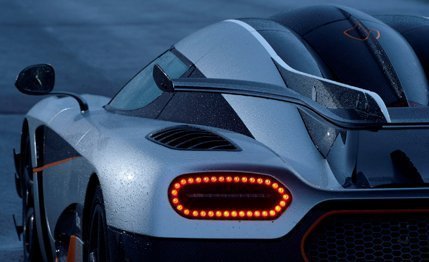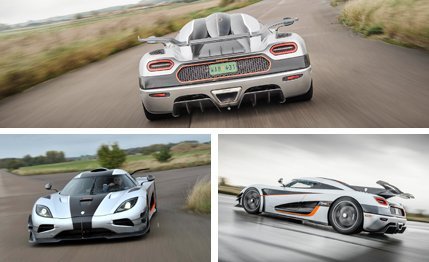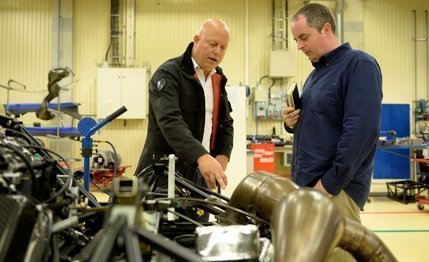 First Drive Review
First Drive Review
Everything is going fine until we reach 150 mph. And then, very suddenly, it’s not.
Just sitting in the passenger seat of the Koenigsegg One:1 (we explain the silly name later) as it attacks a wet runway is, in terms of spiked adrenaline, somewhere between a solo sky dive and being chased by a bull while running in red pants. But as the man from the factory demonstrates, even in the sodden conditions we’ve found waiting for us in Sweden, the world’s fastest car can still be easily controlled. Or so it seemed.
It’s been raining all day, and the One:1 is struggling to put its monstrous power onto the slick surface of the former airbase that serves as Koenigsegg’s test track. The engine is bellowing and the car squirming and sliding as the twin-turbocharged V-8 comes on boost. Even with the stability control switched on and working overtime, it’s struggling to find grip. Running on regular pump gasoline means around 1161 horsepower; 1341 horses and 1011 pound-feet come when it’s fueled with E85. But either way, that’s vastly more twist than the rear Michelins can deliver to the soaked tarmac. Glancing across at the instrument display, I can see that the wheels only stop trying to spin as we pass 125 mph, when serious aerodynamic downforce starts to push the car into the track.

For a couple of heartbeats, we experience the full, brutal acceleration of a car that makes a steam catapult look underpowered.
And then, with a jarring suddenness, the car snaps sideways, and, although the runway is still arriving at an undiminished rate, it’s now coming at the passenger window. A look across the cockpit confirms that this isn’t part of the show; our driver’s face makes it clear that we’re having an unscripted moment in a $2.8 million hypercar. He briefly holds the slide, and then there’s the sensation of momentum shifting, the pendulum swinging back. There isn’t enough opposite lock in the world to catch this one, and sideways becomes backwards toward the edge of the runway.
There’s time aplenty to frame a couple of thoughts. First, and most pressingly, I wonder what will happen if we finish upside down in a car with scissor-hinged doors. Second, and more incongruously, I observe that the grounds-keeping standards have really slipped since the Swedish air force vacated this place 12 years ago. As the edge of the runway approaches, it seems to be made up more of stuff than space: bush, gap, tree, gap, bush, gap, and so on, rushing past like the repeating background in a Hanna-Barbera cartoon.
We’re lucky. We leave the runway through one of the gaps, threading a line between two substantial bushes 50 yards apart at such an angle that we almost hit both. The car comes to rest after another half-rotation, right side up and having encountered nothing harder than scythed grass as it spins to a stop. The cabin is filled with exhaled breath, swearwords in two languages, and nervous laughter. And now it’s my turn to drive.
 Bottom right: The only reason the car didn't fly off this wet runway is because of the staggering aerodynamic downforce keeping it planted.
Bottom right: The only reason the car didn't fly off this wet runway is because of the staggering aerodynamic downforce keeping it planted.
You’d be forgiven for thinking that the Koenigsegg One:1 was designed as an online meme as much as an actual hypercar. Within scant seconds of Koenigsegg releasing the details of this even faster, even more hard-core version of the existing Agera R, it was vying with Kim Kardashian’s backside to break the internet.
Let’s start with the name, which is meant to be pronounced as a ratio, as in “one-to-one,” rather than “one-one.” It refers to both the car’s metric power output of one megawatt (or 1341 horsepower, when running on that E85 alcohol-gasoline blend) and its perfectly balanced power-to-metric-weight ratio. As in, 1.0 kilogram to 1.0 PS (or Pferdestarke, which equals 0.986 horsepower). Did we mention that geeks built this car? Its other claimed numbers read like a fanboy fantasy, too. It’ll go from a dead stop to 250 mph in 20 seconds, reach a 273-mph top speed, and generate 1345 pounds of downforce at 160 mph.
Yet it’s real. Koenigsegg has made it, and we’ve been invited to the factory in Ängelholm in southern Sweden to drive it. In the little jewelry box that is its market, Koenigsegg has become a major player. Only seven One:1s will be made, with four going to Asia, two to Europe, and one to the U.S.

However, should they opt to visit, the hypercar-buying elite won’t exactly be overwhelmed by Koenigsegg’s factory. The low-rise offices and the pair of former aircraft hangars painted turf green offer exactly none of the drama of standing before Ferrari’s famous gate. No evidence of the company’s products is parked outside, and with just 115 cars built over the past 12 years, this is hardly a big-inventory type of operation. Yet Koenigsegg does more under its own roof than almost any other automaker. All the engineering and design is based here; every carbon-fiber part is molded and baked on-site, including components like seat frames and wheels; and the cars are painted and trimmed here. The engines are also built and dyno-tested here. Everything is done by hand, and everything seems to take eons. Assembling the body shell from 400 separate pieces takes 600 hours. Just painting a car takes between 800 and 1200 hours, depending on the finish.
Eventually I meet the One:1, sitting apart from the main production area with its rear clamshell propped up and its scissor-hinged doors open. There isn’t any heavenly music, but it does become impossible to concentrate on anything else. Like the company’s other models, the Won-to-won is not classically beautiful. But it does look devastatingly effective, covered as it is in aerodynamic winglets and vanes and with that vast rear wing, like a blinged-up LMP1 racer.
I’m gawping so hard that it takes longer than it should to realize we’ve been joined by Christian von Koenigsegg himself. The company’s stout, bald founder always looks as if he’s just a white cat away from being a Bond villain, but he’s affability itself in person. He talks me through the GPS-adaptive suspension and its ability to adjust damping corner by corner on selected racetracks, and regrets that the prototype I’ll be driving (and it is the prototype) doesn’t have the active noise-cancellation system the company has designed for the production models. Then, almost as an afterthought, he mentions his and the company’s plans to smash the production-car record at the Nürburgring Nordschleife this year. He figures that both the Agera R and the One:1 will be able to comfortably beat the Porsche 918’s lap of 6 minutes and 57 seconds. “When we look at the sector times, we’re already on course for a record,” he says.